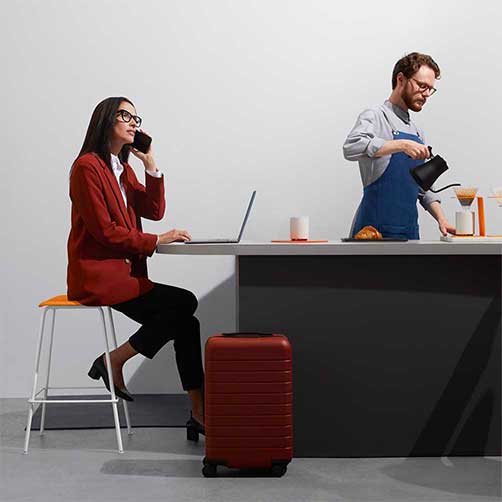Productivity Hacks for Coworking Spaces

Coworking and shared office spaces are growing in popularity thanks to two big changes: Rising rents and a changing workforce. There are now 60 million freelance workers, and by 2027 it’s predicted that a majority of workers in the U.S. will be contractors, reports CNBC.
Analysis from Statista found that coworking spaces have expanded 19 fold from just 1,130 spaces in 2011 to 22,400 in 2019.
Here is how the number of coworking locations has grown through the years:
- 2010: 600
- 2011: 1,130
- 2012: 2,070
- 2013: 3,400
- 2014: 5,780
- 2015: 8,900
- 2016: 12,100
- 2017: 15,500
- 2018: 18,700
- 2019: 22,400
And they’re not all independent real estate locations. Companies like WeWork and Regus have thousands of locations all over the world that provide consistent office standards like office phone systems for small businesses, super-fast VoIP phones, spacious common areas and plenty of networking opportunities.
We all know that coworking spaces have many advantages, though they also present some challenges when it comes to productivity. Whether you’re easily distracted or prone to productivity, let’s look at how you can get the most out of your coworking workday.
The Sound of Productivity
Noise is the chief complaint in open-plan offices. Whether it’s digital sounds like ringing phones or computer notifications, or it’s human sounds of coughing or sneezing, the ambient sounds of coworking spaces can be distracting.
Headphones are the #1 recommendation people give for staying productive. If, for you, productivity sounds like silence, then wear noise-canceling headphones. But if you have a favorite work soundtrack that is keeping you focused, you’re not alone. One study found that workers who listened to music completed their tasks quicker and came up with better ideas than those who didn’t. Just be sure to keep the volume at a reasonable level so the music that’s keeping you focused isn’t a distraction for someone else.
Author Michael Lewis, who wrote “Moneyball,” “The Blind Side” and “The Big Short,” says, “I write with headphones on that just plays on a loop the same playlist that I’ve built for whatever book I’m writing.” It becomes Pavlovian. He hears those songs and starts typing.

Visual Quiet Is Important Too
Similar to distracting sounds, visual noise can also pull you off your task. “You need to create a visual cocoon for yourself,” said author Julie Morgenstern.
Related: Business in the Cloud
It’s good practice to avoid views that are cluttered or chaotic, like trash cans, hallways or kitchens. In fact, some suggest that facing your chair towards the wall can help keep you focused. This is in alignment with the Zen tradition, where meditators face the wall for the same reason: “There’s nothing you can make of a wall but a wall. It’s obstinately resistive to imagination.”
Managing Your Time
The results of effective time management prove that you don’t need longer hours to get more done. The first step is to prioritize your tasks. Acknowledge that inbox zero may be unattainable and work on the most important things first. Try muting unnecessary notifications so you don’t jump into lower-priority tasks.
Additionally, look at how to best structure your time to keep you focused on your work. Experts have determined that a maximum productivity cycle starts with 52 minutes of work, followed by a 17-minute break. Notably, this break is not checking email or Facebook but rather taking a walk or having a conversation. Set timers for how long you’re going to work, and use the rhythm of intense focus and breaks to keep your workday on track.
Coworking spaces have been proven to promote worker productivity. In fact, 64% of coworkers are better able to complete tasks on time.
Procrastination and the 2-Minute Rule
The rules states that if a task can be done in two minutes or less, then do it immediately. This is a hard rule to follow for anyone who tends to procrastinate. However, postponing the task and returning to it later will use more of your time.
In a series of satirical email responses about belated emails, The New Yorker wrote this email message that we all want to avoid: “Sorry for the delay! I put off answering your email until I had an even more tedious task that I wanted to avoid. Thanks!”

Work-Life Harmony
While it may seem easier to work from a home office or run business from your mobile, separating work and life can be beneficial for both.
Working from home blurs the line between your work and regular life, which means you stay on the clock longer and work when you could instead spend time with your family or relax.
If you can’t afford to turn a spare room into a dedicated office, or you have a lot of people coming in and out of your home during the day, this can affect both your work and your relationships with family. Thus, a clear separation is best.
In fact, workers who chose a coworking space said their home life improved after making the switch. Since coworking, they were 60% more relaxed at home and had 91% better personal interactions.
Related: PBX system for small business
Coworking also helped them during the workday. While coworking, 68% had better focus and 50% produced higher earnings after coworking.
Go to Geek Prank and try the online Windows XP simulator, play with the classic Minesweeper and Tetris games or listen to some music.

Learn more about how Ooma Office can help your business.
Thank you!
An Ooma Office Sales Representative will be in touch shortly.
866-573-0707


Learn more about how Ooma Office can help your business.
Just call 877-621-0515 or click this to CHAT. Or, fill out this form and someone will reach out to you shortly.



